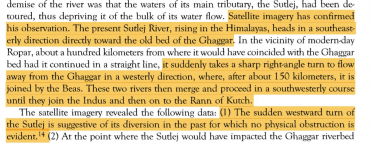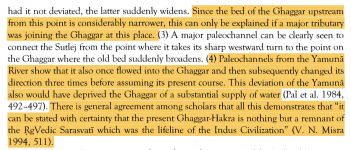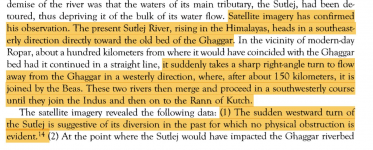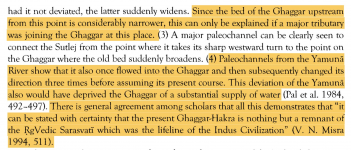SavageKing456
Active member
The initial evidence for the existence of the Sarasvati came solely from the Rigveda between the Yamuna on the East & Sutlej on the West.It is precisely between this and the next 'fact' that you have mentioned that there is a gulf. Placing the Saraswati between the Yamuna and the Sutlej DOES NOT identify the Ghaggra as that Saraswati; it merely encourages speculation that this might be a possible candidate. That is not proof, that is speculation, informed speculation, but one that breaks down in very short order.
It is precisely for this reason that regressive and wishful thinkers keep trying to push back the date of the Vedas. For one thing, if the Vedic reference to the foaming river is to be identified to the Ghaggra, that river had already dried up by 1300 BCE. So the only way to wish ourselves into being the originators of the IVC is to push back the date of the composition of the Vedas to the dates when the Ghaggra was in full flow.
There is a problem with that. A problem that a mind looking desperately for such an identification will not notice.
The problem can be explained in the following points (these are the findings of palaeo-geologists, the same people who think that the dried-up Ghaggra could have been the Saraswati):
This should make clear that for the first reference to the Saraswati in the Rg Veda, a foaming brimful river, the Rg Veda should have been composed around 8,000 to 10,000 years ago, when there was no urban community, and only neolithic settlements of hunter-gatherers in archaeological terms, and only the wishful thinking of regressives to suggest that any kind of civilisation existed then.
- The Sutlej, and possibly also the Yamuna, flowed south-west into the Hakra, and from there, according to satellite imagery, into the Nara River, a delta channel of the Indus, that today falls into the sea by way of Sir Creek.
- Around 8,000 to 10,000 years ago, the Sutlej changed course, as did the Yamuna, the latter becoming a tributary of the Ganges system. THIS WAS WELL BEFORE THE INDUS VALLEY CIVILISATION HAD BEGUN.
- By 5,000 years ago (another way of saying this is around 3500 BCE, that is, 3,500 + 2,100 = 5,600 years ago), the monsoon rains had diminished. This allowed urban settlements to flourish along the banks of the now-seasonal river system, that is known as the Ghaggra until it falls into the Hakra.
- Contrary to what many people in India think, not every settlement was of a major size. Many of these sites were quite small. The number of sites does not therefore indicate the centre of gravity of the civilisation, merely its extent and spread.
- Between 2500 BCE and 1900 BCE, the course of the channels changed; the older course was left even more short of water, and this was when the decline of the IVC began, in archaeological terms. The end came about 1300 BCE, or about 3,400 years ago.
- It was not an abrupt ending; there was gradual, extended degradation, with the orderly plan of the settlements becoming compromised step by step, with buildings in the middle of what were once empty streets.
- The people abandoned these decaying settlements and, according to pottery remains, and grave-sites (the SWAT Culture and the Cemetery H, and in pottery, the Ochre pottery as a starting and tracking point), spread out in the north-east into the Punjab-Haryana plains (Rakhigarhi being such a site); in the south-east, it went east beyond Lothal into the hinterland.
It also requires a reconciliation of the canonical dates of the Indo-Iranian movement from the Andronovo Culture to the Oxus-Jaxartes region by 2000 BCE or so, and the westward movement of the Mitanni to Anatolia, where their peace treaties spoke of Varuna, the Nasatyas and Indra, and their horse training treatises faithfully followed the Indo-Iranian, and thereafter, the Indo-Aryan numbering system. Unfortunately, those who keep trying to establish the OOI fail at reconciling these points.
On the other hand, that there was renewed effort at setting up urban settlements after the collapse of the IVC and that a percentage of steppe dwellers were involved, is clear from archaeological evidence.
The second reference to the Saraswati in the Rg Veda is to a river that disappears into the desert. This is precisely the condition of the Ghaggar in the period 1300 BCE, around 200 years after the first migrants had entered south Asia. If there is to be an identification of the Ghaggar with the Vedic river, it is this reference that is logical and consistent with the facts, and not the other, earlier one.
It is for these reasons that it is unlikely that the Ghaggar was the Saraswati of Vedic times. At least, it was not the brimful Saraswati; it may have been the Saraswati disappearing into the desert.
<sigh>
This brimful phase was long before any traces of urban development. For your information, the archaeological research of Raymond and Bridget Allchin showed the gradual growth of villages, then towns, then the full-fledged cities of the IVC, spreading down from the Afghan plateau, to the Indus valley banks, and then proliferating along channels of the Indus and its tributaries. These are clear signs of systematic growth and development, not planned by some higher authority, but as the natural progression of urban development.
It is also clear that the urbanisation along the banks of the Ghaggar was most convenient when weather conditions permitted, not at a time of flooded rivers, but at a time of lesser monsoon precipitation and lesser river activity. That would also explain why there are so many more urban settlements, even though of smaller sizes, along these shrinking tributaries, than along the main Indus itself.
C.F Oldham, in 1874, correctly identified the dry bed of the Ghaggar-Hakra with the once mighty Sarasvati. He was convinced it was the Sarasvati.
Oldham said, the Sarasvati was fed by the Sutlej & the Yamuna, (both correct) but later the Sutlej changed it's course, drying the river up. However, there were many who doubted this, until satellite imagery CONFIRMED that the Sutlej had fed the Ghaggar before.
As for Helmand is called the Haetumant in the Venidad (Fargard 1.13) It was NEVER called "Haraxvati"
Haraxvati is mentioned in the Avesta, but it has been identified with the modern-day Arghandab river, which is a small tributary of the Helmand river. Sarasvati is a mighty flowing river present b/w the Sutlej & Yamuna (according to the Rigveda)
The geography is clearly in NW plains of Sapta Sindhu
All this was finally put to rest by a Nature paper on geographical sedimentary deposits of the Ghagra last december that sealed the deal & identified it with the Sarasvati river.
"Our study brings to light the fact that the Harappans built their early settlements along a stronger phase of the river Ghaggar, during ~9 to 4.5 ka, which would later be known as the Saraswati. " The study confirms the Sutlej & Yamuna fed the Ghaggar.

Scientists show how Himalayan rivers influenced ancient Indus civilization settlements
The Indus or Harappan Civilisation was a Bronze Age society that developed mainly in the northwestern regions of South Asia from 5300 to 3300 years ago, at about the same time as urban civilisations developed in Mesopotamia and Egypt. Archaeological evidence shows that many of the settlements in...
Attachments
Last edited:










